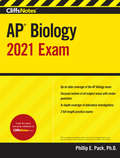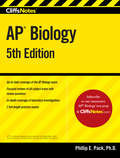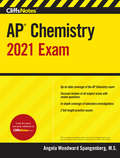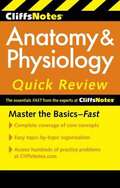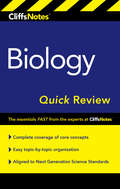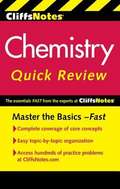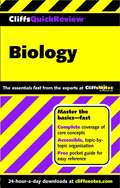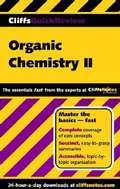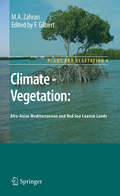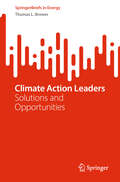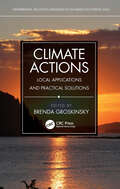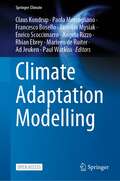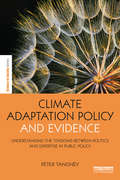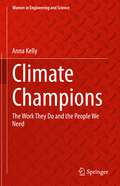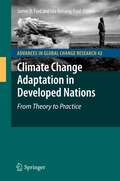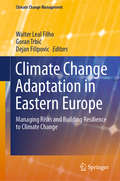- Table View
- List View
CliffsNotes AP Biology 2021 Exam
by Phillip E. PackCliffsNotes AP Biology 2021 Exam gives you exactly what you need to score a 5 on the exam: concise chapter reviews on every AP Biology subject, in-depth laboratory investigations, and full-length model practice exams to prepare you for the May 2021 exam. Revised to even better reflect the new AP Biology exam, this test-prep guide includes updated content tailored to the May 2021 exam. Features of the guide focus on what AP Biology test-takers need to score high on the exam:Reviews of all subject areasIn-depth coverage of the all-important laboratory investigationsTwo full-length model practice AP Biology examsEvery review chapter includes review questions and answers to pinpoint problem areas.
CliffsNotes AP Biology, 5th Edition
by Phillip E. PackScore higher with this new edition of the bestselling AP Biology test-prep book Revised to even better reflect the AP Biology exam, this AP Biology test-prep guide includes updated content tailored to the exam, administered every May. Features of the guide focus on what AP Biology test-takers need to score high on the exam:Reviews of all subject areasIn-depth coverage of the all-important laboratory investigationsTwo full-length model practice AP Biology examsEvery review chapter includes review questions and answers to pinpoint problem areas.
CliffsNotes AP Chemistry 2021 Exam
by Angela Woodward SpangenbergCliffsNotes AP Chemistry 2021 Exam gives you exactly what you need to score a 5 on the exam: concise chapter reviews on every AP Chemistry subject, in-depth laboratory investigations, and full-length model practice exams to prepare you for the May 2021 exam. Revised to even better reflect the new AP Chemistry exam, this test-prep guide includes updated content tailored to the May 2021 exam. Features of the guide focus on what AP Chemistry test-takers need to score high on the exam: <P><P>Reviews of all subject areasIn-depth coverage of the all-important laboratory investigationsTwo full-length model practice AP Chemistry examsEvery review chapter includes review questions and answers to pinpoint problem areas.
CliffsNotes Anatomy & Physiology Quick Review, 2nd Edition
by Steven BassettInside the Book: Anatomy and Chemistry Basics The Cell Tissues The Integumentary System Bones and Skeletal Tissues The Skeletal System Joints Muscle Tissue The Muscular System Nervous Tissue The Nervous System The Sensory System The Endocrine System The Cardiovascular System The Lymphatic System The Immune System and Other Body Defenses The Respiratory System The Digestive System The Urinary System The Reproductive System Review Questions Resource Center Glossary Index Why CliffsNotes? Access 500 additionalpractice questions at www.cliffsnotes.com/go/quiz/anatomy_physiology Go with the name you know and trust Get the information you need-fast! CliffsNotes Quick Review books give you a clear, concise, easy-to-use review of the basics. Introducing each topic, defining key terms, and carefully walking you through each sample problem, these guides help you grasp and understand the important concepts needed to succeed. The essentials FAST from the experts at CliffsNotes Master the Basics-Fast Complete coverage of core concepts Easy topic-by-topic organization Access hundreds of practice problems at www.cliffsnotes.com/go/quiz/anatomy_physiology
CliffsNotes Biology Quick Review Third Edition
by Kellie Ploeger CoxA no-nonsense, quick review of biology for high school and college studentsCliffsNotes Biology Quick Review, 3rd Edition, provides a clear, concise, easy-to-use review of biology basics. Perfect for high school and college students, teacher candidates taking the Praxis Biology test, and anyone wanting to brush up on their biology knowledge. Whether you're new to elements, atoms, and molecules or just wanting to refresh your understanding of the subject, this guide can help. Aligned to NGSS, it includes topics such as cellular respiration, photosynthesis, mitosis and cell reproduction, genetics, DNA, and plant and animal structures and functions. The target audience is high school and college students: 96% of high school students take a biology course before graduating, and biology "101" is a staple at all colleges and universities.
CliffsNotes Chemistry Quick Review, 2nd Edition
by Robyn L Ford Charles Henrickson Harold D NathanInside the Book: Elements Atoms Atomic Structure Electron Configurations Chemical Bonding Organic Compounds States of Matter Gases Solutions Acids and Bases Oxidation-Reduction Reactions Electrochemistry Equilibrium Thermodynamics Review Questions Resource Center Glossary Why CliffsNotes? Go with the name you know and trust Get the information you need-fast! CliffsNotes Quick Review guides give you a clear, concise, easy-to-use review of the basics. Introducing each topic, defining key terms, and carefully walking you through sample problems, this guide helps you grasp and understand the important concepts needed to succeed. Access 500 additional practice questions at www.cliffsnotes.com/go/quiz/chemistry Master the Basics -Fast Complete coverage of core concepts Easy topic-by-topic organization Access hundreds of practice problems at www.cliffsnotes.com/go/quiz/chemistry
CliffsQuickReview Biology
by Kelly Schweitzer I. Edward AlcamoCliffsQuickReview course guides cover the essentials of your toughest subjects. Get a firm grip on core concepts and key material, and test your newfound knowledge with review questions.Whether you're new to elements, atoms, and molecules or just brushing up on your knowledge of the subject, CliffsQuickReview Biology can help. This guide carries biological studies into topics such as organic compounds, cellular respiration, transgenic animals, and human reproduction. You'll also tackle other concepts, includingThe process of photosynthesisMitosis and cell reproductionInheritance patternsPrinciples of evolutionThe unity and diversity of lifeCliffsQuickReview Biology acts as a supplement to your other learning materials. Use this reference in any way that fits your personal style for study and review -- you decide what works best with your needs. You can flip through the book until you find what you're looking for -- it's organized to gradually build on key concepts. Here are just a few other ways you can search for topics:Use the free Pocket Guide full of essential information.Get a glimpse of what you'll gain from a chapter by reading through the Chapter Check-In at the beginning of each chapter.Use the Chapter Checkout at the end of each chapter to gauge your grasp of the important information you need to know.Test your knowledge more completely in the CQR Review and look for additional sources of information in the CQR Resource Center.Use the glossary to find key terms fast.With titles available for all the most popular high school and college courses, CliffsQuickReview guides are comprehensive resources that can help you get the best possible grades.
CliffsQuickReview Organic Chemistry II
by Frank PellegriniCliffsQuickReview course guides cover the essentials of your toughest classes. You're sure to get a firm grip on core concepts and key material and be ready for the test with this guide at your side.Whether you're new to biosynthesis, integrated metabolism, and the molecular cloning of DNA or just brushing up on those topics, CliffsQuickReview Organic Chemistry II can help. This guide introduces each topic, defines key terms, and walks you through each sample problem step-by-step. In no time, you'll be ready to tackle other concepts in this book such asThe reactions of aromatic compoundsAldol, cross-aldol, and ketonic aldol condensationEster formationOxidationMass spectraCliffsQuickReview Organic Chemistry II acts as a supplement to your textbook and to classroom lectures. Use this reference in any way that fits your personal style for study and review -- you decide what works best with your needs. You can either read the book from cover to cover or just look for the information you want and put it back on the shelf for later. What's more, you canGet a glimpse of what you'll gain from a chapter by reading through the introduction at the beginning of each chapterStudy your formulas in the Summary of Preparations or the Summary of ReactionsUse the glossary to find key terms fast.With titles available for all the most popular high school and college courses, CliffsQuickReview guides are a comprehensive resource that can help you get the best possible grades.
Climate - Vegetation: Afro-Asian Mediterranean and Red Sea Coastal Lands (Plant and Vegetation #4)
by M. A. Zahran Francis GilbertDeserts are unique ecosystems with their own biotic and abiotic components, and are often rich in renewable natural resources, the appropriate management of which can contribute significantly to the sustainable management of desert regions for the welfare of the people. Yet while there are many books on the flora of the countries fringing the important desert countries of the Mediterranean and Red Seas, there or few books reporting on their ecophysiology and vegetation ecology. This book presents the vegetation types of the African and Asian countries of the Mediterranean and Red Sea coastal regions, and discusses the ecological threats and economic applications of these critical resources. In particular, it examines the relationships between climate and vegetation, and discusses these within the context of desertification, agro-industrial applications, ecotourism and sustainable development. The book will provide a valuable reference for researchers and graduate students involved in plant ecology, biogeography, economic botany and environmental management in the Afro-Asian Mediterranean and Red Sea coastal regions, as well as other desert regions around the world.
Climate Action Leaders: Solutions and Opportunities (SpringerBriefs in Energy)
by Thomas L. BrewerThe book is a unique compendium and handbook that identifies and describes many specific, tangible climate change actions taken by leaders in various sectors. It is partly a casebook of constructive, innovative examples, designed to inspire and inform further actions. There are three principal categories of cases in the book: technologies, government policies, and business practices. The chapters are not merely lists of individuals or organizations; they are assessments of actions with diverse origins and a variety of specific objectives. Such actions have been taken in diverse sectors, including electric power generation and distribution, transportation, cement, steel, petrochemicals, construction and operation of buildings, agriculture, insurance, and banking. Actions from countries in all regions of the world are included, as are governmental actions at all levels from local to global. The book serves as a key reference for students and experts in many fields, aiming to inspire leaders to learn from the successful actions others have taken to limit and mitigate the effects of climate change.
Climate Action Through Eco-Friendly Textiles (SDGs and Textiles)
by Rajesh Kumar Sadhna S. GreeshmaThis book covers the latest developments in sustainable textiles and how they can help mitigate the fashion industry's environmental impact. It focuses on innovative textile production approaches by prioritizing eco-friendly materials, responsible sourcing, ethical manufacturing practices, using cutting-edge technology to create textiles that are not only sustainable but also high-performing and durable. This book further explores the wide range of possibilities for reducing the fashion industry's environmental impact, from natural dyeing techniques to biodegradable fibers. This book will be of interest to students, researchers, fashion industry professionals, environmentalists and anyone who is interested in learning more about sustainable fashion.
Climate Action and Hydrogen Economy: Technologies Shaping the Energy Transition (Green Energy and Technology)
by Gautam Sen Malti GoelThis book focuses on up-to-date progress on the current status of technology and progress in climate action and hydrogen energy in India. It includes contributions from leading experts, and covers emerging topics such as issues & challenges in moving toward hydrogen economy, green hydrogen production technologies, hydrogen production from liquid hydrogen carriers, policy perspectives on hydrogen as energy source of the future, hybrid approaches for solar hydrogen, among others. This book is of interest to those working in academia, industry and policymakers in the field of energy.
Climate Actions: Local Applications and Practical Solutions (Environmental and Societal Dimensions of Sustainable Development Goals)
by Brenda GroskinskyThis book offers a diverse set of solid concerted strategies in the development and implementation of specific "climate actions," in natural and built places where we all live. The book also serves as a conduit of knowledge for those who are unsure on how they can make a difference for their families, their communities, and the natural places that surround them. Through many actionable examples of mitigation efforts for the ever-present effects of climate change, especially for those who may not understand the wide range of climate action opportunities that are available. Scientists, academics, and community leaders, will find concrete examples on how they too, can develop and implement climate action solutions.
Climate Adaptation Modelling (Springer Climate)
by Jaroslav Mysiak Claus Kondrup Paola Mercogliano Francesco Bosello Enrico Scoccimarro Angela Rizzo Rhian Ebrey Marleen De Ruiter Ad Jeuken Paul WatkissThis open access book focuses on an issue only marginally tackled by this literature: the still existing gap between adaptation science and modelling and the possibility to effectively access and exploit the information produced by policy making at different levels, international, national and local. To do so, the book presents the proceedings of a high-level expert workshop on adaptation modelling, integrated with main results from the “Study on Adaptation Modelling” (SAM-PS) commissioned by the European Commission's Directorate-General for Climate Action (DG CLIMA) and implemented by the CMCC Foundation – Euro-Mediterranean Centre on Climate Change, in collaboration with the Institute for Environmental Studies (IVM), Deltares, and Paul Watkiss Associates (PWA).What is the latest development in adaptation modelling? Which tools and information are available for adaptation assessment? How much are they practically usable by the policy community? How their uptake by practitioners can be improved? What are the major research gaps in adaptation modelling that needs to be covered in the next future? How? This book addresses these questions presenting the results of a study on adaptation modelling commissioned by the European Commission's Directorate-General for Climate Action (DG CLIMA) enriched by the outcomes of a high-level expert workshop on adaptation also part of the research. This book aspires to provide a useful support to academics, policy makers and practitioners in the field of adaptation to orient them in the expanding adaptation modelling assessment literature and suggest practical ways for its application. This book, mainly addressed to academics, policy makers and practitioners in the field of adaptation, aims to providing orientation in the large and expanding methodological/quantitative literature, presenting novelties, guiding in the practical application of adaptation assessments and suggesting lines for future research. This open access book focuses on an issue only marginally tackled by this literature: the still existing gap between adaptation science and modelling and the possibility to effectively access and exploit the information produced by policy making at different levels, international, national and local. To do so, the book presents the proceedings of a high-level expert workshop on adaptation modelling, integrated with main results from the “Study on Adaptation Modelling” (SAM-PS) commissioned by the European Commission's Directorate-General for Climate Action (DG CLIMA) and implemented by the CMCC Foundation – Euro-Mediterranean Centre on Climate Change, in collaboration with the Institute for Environmental Studies (IVM), Deltares, and Paul Watkiss Associates (PWA).
Climate Adaptation Policy and Evidence: Understanding the Tensions between Politics and Expertise in Public Policy (The Earthscan Science in Society Series)
by Peter TangneyEvidence-based policymaking is often promoted within liberal democracies as the best means for government to balance political values with technical considerations. Under the evidence-based mandate, both experts and non-experts often assume that policy problems are sufficiently tractable and that experts can provide impartial and usable advice to government so that problems like climate change adaptation can be effectively addressed; at least, where there is political will to do so. This book compares the politics and science informing climate adaptation policy in Australia and the UK to understand how realistic these expectations are in practice. At a time when both academics and practitioners have repeatedly called for more and better science to anticipate climate change impacts and, thereby, to effectively adapt, this book explains why a dearth of useful expert evidence about future climate is not the most pressing problem. Even when it is sufficiently credible and relevant for decision-making, climate science is often ignored or politicised to ensure the evidence-based mandate is coherent with prevailing political, economic and epistemic ideals. There are other types of policy knowledge too that are, arguably, much more important. This comparative analysis reveals what the politics of climate change mean for both the development of useful evidence and for the practice of evidence-based policymaking.
Climate Champions: 15 Women Fighting for Your Future (Women of Power #10)
by Rachel SarahThese 15 contemporary climate champions are on the frontlines of science to create a sustainable future on Earth.They are climate scientists, journalists, professors, academics, researchers, and policy makers from around the world who draft policies with real-world impact, run science labs to find new answers to old problems, and lead organizations at the forefront of change. These women do not shy away from showing how racial and social injustices lie at the root of so many climate-related issues. Their stories are accessible and energetic, with spotlights on the triumphs and struggles of women who are working to protect the planet. As young readers learn how these champions are rising up around the world, they will learn how to be part of the solution.
Climate Champions: The Work They Do and the People We Need (Women in Engineering and Science)
by Anna KellyIn this groundbreaking work, readers will discover a wealth of innovative and impactful advancements in the field of climate change. A call to action for those working to arrest or mitigate the impacts of this global crisis, this book showcases the tireless dedication of a workforce committed to creating a better world. Despite the despair and anger that often accompany discussions of climate change, this book offers a refreshing perspective by highlighting the moments of hope and pride that arise when individuals see their efforts have tangible, measurable impacts. Readers will also be inspired to learn that they don't have to be scientists or engineers to make a difference. The author illustrates how every person with an interest in protecting the environment, the global food supply, and geopolitical stability can join the fight, whether by improving the efficiency of manufacturing operations or by contributing to the manufacture of life-saving medicines. This is a must-read for anyone who cares about the environment, our global community, and our collective future.
Climate Change
by Pamela Doughman Joseph F.C. DiMentoMost of us are familiar with the term climate change but few of us understand the science behind it. We don't fully comprehend how climate change will affect us, and for that reason we might not consider it as pressing a concern as, say, housing prices or unemployment. This book explains the scientific knowledge about global climate change clearly and concisely in engaging, nontechnical language, describes how it will affect all of us, and suggests how government, business, and citizens can take action against it. This completely revised and updated edition incorporates the latest scientific research and policy initiatives on climate change. It describes recent major legislative actions, analyzes alternative regulatory tools including new uses of taxes and markets, offers increased coverage of China and other developing nations, discusses the role of social media in communicating about climate change, and provides updated assessments of the effects of climate change. The book first explains the basic scientific facts about climate change and its global impact. It discusses the nature of scientific consensus and the strong consensus of mainstream science on climate change. It then explores policy responses and corporate actions in the United States and the rest of the world, discusses how the communication of climate change information by journalists and others can be improved, and addresses issues of environmental justice -- how climate change affects the most vulnerable populations and regions. We can better tackle climate change, this book shows us, if we understand it.
Climate Change
by Philippe De LarminatUnder certain scenarios on the subject of CO2 emissions, by the end of the century the atmospheric concentration could triple its pre-industrial level.The very large numerical models intended to anticipate the corresponding climate evolutions are designed and quantified from the laws of physics. However, little is generally known about these: genesis of clouds, terms of the greenhouse effect, solar activity intervention, etc. This book deals with the issue of climate modeling in a different way: using proven techniques for identifying black box-type models. Taking climate observations from throughout the millennia, the global models obtained are validated statistically and confirmed by the resulting simulations.This book thus brings constructive elements that can be reproduced by anyone adept at numerical simulation, whether an expert climatologist or not. It is accessible to any reader interested in the issues of climate change.
Climate Change Adaptation Actions in Bangladesh (Disaster Risk Reduction)
by Rajib Shaw Aminul Islam Fuad MallickThe book outlines the climate change adaptation (CCA) actions in Bangladesh drawing examples and lessons from different projects and programs in the country. The content is based on a selection of available documents, a consultative workshop with the academicians from different universities undertaking higher education on disaster risk reduction and climate change adaptation, and the editors' own knowledge and experience in the field. The book has four parts. Part I gives the details of climate change impacts, providing the scenarios, negotiations, and specific impacts on sea-level rise and the health sectors. Part II focuses on climate change strategy and action plans. Part III covers socio-economic impacts in terms of economic and environmental costs. Part IV focuses on adaptive actions for agriculture, livelihoods, and integrated approaches in agriculture and fisheries. Part V deals with climate-change governance issues. The primary target groups for this book are students and researchers in the fields of environment, disaster risk reduction, and climate change studies. The book will provide them with a good idea of the current trend of research in the field and will furnish basic knowledge on this important topic in Bangladesh. Another target group comprises practitioners and policy makers, who will be able to apply collective knowledge to policy and decision making.
Climate Change Adaptation Framework and Youth Entrepreneurship in West Africa (Sustainable Development Goals Series)
by Andrew SimmonsThis book's purpose is to highlight the development challenges and successes of implementing the Youth Climate Change Adaptation Development Framework in Sierra Leone, West Africa. Over the past decade, Sierra Leone has experienced a series of development challenges, including internal conflict and Ebola outbreaks in most recent times. The dire unemployment situation in Sierra Leone is compounded by the emergence of climate change that negatively impacts all aspects of daily life and wellbeing, and the education and training provided do not prepare young people adequately for the job market. Therefore, building youth resilience to adapt to the impact of climate change and other development problems is a significant development challenge faced by policymakers in Sierra Leone. The government, through funding from the African Development Bank (AfDB), has provided support for the implementation of a Youth Employment and Entrepreneurship Project (YEEP) to reinforce the employability of Sierra Leone Youth as well as enhance their entrepreneurship and employment skills through the development of a framework that integrates education and vocational institutions with job market demand and supply. This approach has resulted in strengthening the occupational levels in the youth population segments of the country. This book discusses the objectives and outcomes of this project, including curricula for Sustainable Construction, training of counselors and administrators, providing youths with supervisory skills, and developing tools to assess youth development institutions' weaknesses and enhance institutional capacity to deliver climate change adaption for sustainable development programmes. The book can be used by policymakers from Small Island Developing States (SIDS) and LDCs in Africa and Asia. It can be used by researchers working on Climate Change, Education, Sustainable Development, emphasising Climate Change Education for Sustainable Development in both developing and developed countries. It can also be used by practitioners involved in implementing innovations in youth development, employment, entrepreneurship, sustainable livelihoods initiatives, climate change adaptation, and mitigation. These practitioners and researchers would find this book an invaluable resource to support their work in the field.
Climate Change Adaptation and Mitigation in the Seaflower Biosphere Reserve: From Local Thinking to Global Actions (Disaster Risk Reduction)
by José Ernesto Mancera Pineda Andrés F. Osorio Cesar Toro Carolina Sofía Velásquez-CalderónThis open access book addresses the following topics for the Seaflower Biosphere Reserve (BR) in the Colombian Archipelago of San Andrés, Providencia, and Santa Catalina, in the southwest Caribbean Sea, which is the world’s largest BR and contains representative ecosystems of tropical island regions. ● Future regional climate behavior and forms of balanced relationships between humans and nature to promote climate change (CC) adaptation and mitigation strategies for tropical islands. ● The relevance of BRs as ideal locations to study and replicate interdisciplinary adaptation strategies. BRs are “living, dynamic laboratories” where local communities demonstrate safe and sustainable development possibilities. Island and coastal tropical BRs disproportionately face adverse effects of CC, making them a research priority with unprecedented intellectual challenges for their unique characteristics. This collaborative effort ● Stimulates critical and interdisciplinary thinking around tropical island regions ● Presents new and different angles to understand local socioenvironmental impacts of CC ● Demonstrates the linkage between ecosystem services, human well-being, and CC adaptation ● Connects local experiences to global dynamics and processes, and vice versa ● Places the struggles and knowledge of the indigenous Raizal people at the forefront of CC and BR studies ● Examines relevant socioenvironmental pathways toward collective action for adaptive capacity, resilience, and ultimately contributes to sustainable development processes in BRs worldwide. This book was financed by the Corporation Center of Excellence in Marine Sciences (CEMarin).
Climate Change Adaptation from Geotechnical Perspectives: Select Proceedings of CREST 2023 (Lecture Notes in Civil Engineering #447)
by Hemanta Hazarika Stuart Kenneth Haigh Babloo Chaudhary Masanori Murai Suman ManandharThis book presents select proceedings of the 2nd International Conference on Construction Resources for Environmentally Sustainable Technologies (CREST 2023), and focuses on sustainability, promotion of new ideas and innovations in design, construction and maintenance of geotechnical structures with the aim of contributing towards climate change adaptation and disaster resiliency to meet the UN Sustainable Development Goals (SDGs). It presents latest research, information, technological advancement, practical challenges encountered, and solutions adopted in the field of geotechnical engineering for sustainable infrastructure towards climate change adaptation. This volume will be of interest to those in academia and industry alike.
Climate Change Adaptation in Developed Nations: From Theory to Practice (Advances in Global Change Research #42)
by James D. Ford Lea Berrang-FordIt is now widely accepted that adaptation will be necessary if we are to manage the risks posed by climate change. What we know about adaptation, however, is limited. While there is a well established body of scholarship proposing assessment approaches and explaining concepts, few studies have examined if and how adaptation is taking place at a national or regional level.
Climate Change Adaptation in Eastern Europe: Managing Risks And Building Resilience To Climate Change (Climate Change Management Ser.)
by Walter Leal Filho Dejan Filipovic Goran TrbicThis book focuses on managing risks and building resilience to climate change, showcasing experiences from research, field projects and best practices to foster climate change adaptation in Eastern Europe that can be implemented elsewhere.Climate change affects countries in Eastern Europe, i.e. the Western Balkans and Southeast Europe in a variety of ways. Apart from severe floods, there are reports of decreasing water reserves in the southern regions, and of gradual changes in biodiversity and agricultural production. In the South Caucasus area, for instance, climate change models project a decline in precipitation and suggest that it will continue to become drier this century.Many Eastern European countries, especially the non-EU ones, have weak national climate policies, and transboundary collaborations, as well as limited public engagement in matters related to climate change. As a result, climate change poses a serious threat to their economic stability and development and to the sustainable development of the region.The above state of affairs illustrates the need for a better understanding of how climate change influences Eastern Europe, and for the identification of processes, methods and tools that may help the countries and the communities in the region to adapt. There is also a perceived need to showcase successful examples of how to cope with the social, economic and political problems posed by floods/droughts in the region, especially ways of increasing the resilience of agriculture systems and of communities.Addressing this need, the book presents papers written by scholars, social practitioners and members of government agencies involved in research and/or climate change projects in Eastern Europe.
